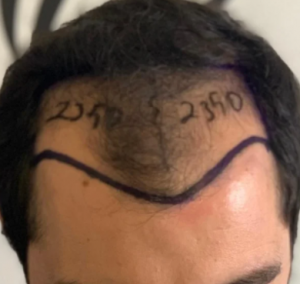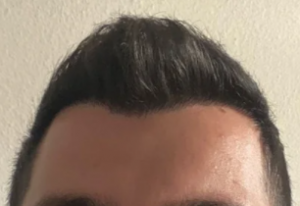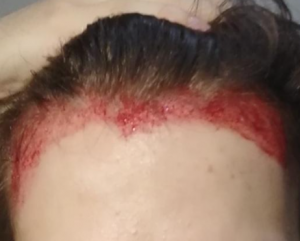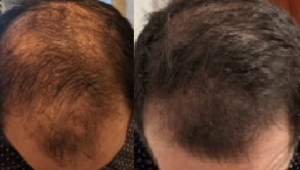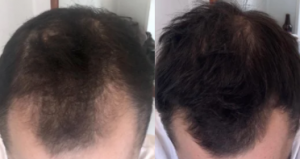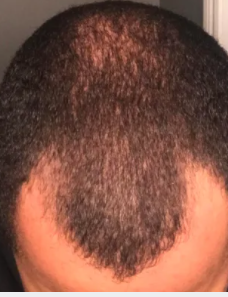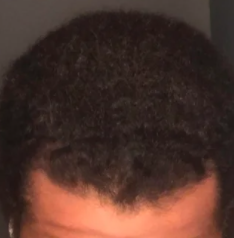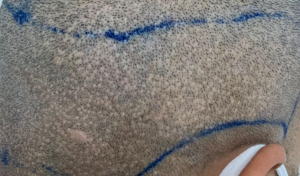The look is great, but you have used up more than 50% of your donor supply which could be a problem if your balding pattern significantly advances. I would ask your surgeon a simple question: “Could the same results have been achieved with 3000 grafts (1500 each side)? If your hair has a medium or better thickness, the answer is ‘yes’ in my opinion.
Once a week to every ten days is the routine for microneedling. You just have to hold the pen against the skin and the instrument will take care of the depth as it cycles. The use of a Dr. Pen microneedling device at a depth of 1.5mm can produce considerable bleeding. You should probably reduce the needle depth to 1mm so that the bleeding will not be so great. There is another problem I see here, and that is the area you covered is the same area as your original juvenile hairline. The juvenile hairs in that old hairline are unlikely to come back. The area where you have receded, will more likely come back which reflects the transition to a mature hairline possibly with recession. That is within the area outlined by the blood. I would like to see a mature hairline drawn on your head and then see you microneedle that area. Read my article on hairlines that mature: https://newhair.com/wp-content/uploads/2018/11/phenotype-article-published.pdf
I see. So in colloquial terms when men self-report visually obvious “hair thinning,” is that usually the same thing as miniaturization? Or is miniaturization more about individual hair diameter rather than density?
Thinning reported by the patient can be miniaturization, decrease of hair density (hairs falling out) or generalized thinning of all hairs (both donor and recipient hair) as noticed in aging. This aging process can occur in men and women as early as 30-40 years old, but mostly they are past 50 and commonly found in the general population.
I was wondering if maybe I was just a bad candidate and my hairs were doomed to die, but you suggest that operator error and inexperience is the main cause of a failed transplant. This gives me hope that a second procedure with a better surgeon may result in better growth.
You need a good doctor to make sure that you don’t have some underlying disease such as Frontal Fibrosing Alopcia or LLP which can cause failures of a hair transplant
I was cleaning out my dad’s apartment he recently passed from COVID-19 and as I was cleaning out the drawers and cabinets he filed his paperwork. He passed away with a NW7, a tiny fringe of hair on the sides behind his ears and the back of neck. MPB destroyed all of his follicles decades ago. He died at 83 years old. All I saw were pamphlets and envelopes for more information pertaining to Bosley Hair Club for men. A lot of them and yet he never acted on them over the years. And I could tell that while he was alive, his bald appearance really bothered him front the amount of all of the Bosley stuff I found which was extensive. What it told me was DO anything you have to while you are here to feel better about YOURSELF.
What constitutes to be as a “massive” shed which retreats my hairline – in all honesty, may not be all that bad to someone with more severe balding. I did shed a ton, but my hair was largely intact. My hairline, however – was a different story.
I also think, due to the shifting of phases between hair follicles – a hair shed is almost inevitable and is certainly a sign which isn’t only regular, but honestly quite indicative of treatment working. Whilst you, personally, may not have encountered sheds, I have seen you interact with countless people on forums who do mention it.
For peace of mind purposes, it should be clearly stated; if you notice an increased shedding in the weeks following starting or restarting a new hairloss treatment method, it’s likely the treatment working! The odds that your genetics suddenly decided to get worse when you started treatment and thus resulted in a mass shed is absolutely minimal.
I don’t have evidence in published articles that link a significant shed from finasteride as a predictor of how it will work.
According to this study (https://onlinelibrary.wiley.com/doi/full/10.1002/brb3.1645#brb31645-sec-0008-title) lower DHT levels are associated with ALS! I’m worried that this means finasteride, something that lowers DHT, can maybe cause ALS even thought it’s rare! Thoughts?
From reading the article quickly, I did not see a 1:1 connection between low DHT and ALS. The authors postulated that low DHT may have a role, but the evidence is not strong.
I generally like the hair long, at least 2 inches so I have the option to perform a HAIRCHECK test on all of my initial patients (https://baldingblog.com/haircheck-test-how-it-is-done-video/) and I can see the effects of miniaturization better when the hair has length.
I had an ARTAS FUE transplant one year ago and roughly 15% of the transplanted hair has grown in. To say it is a massively expensive disappointment is an understatement. I’m planning on asking the company/surgeon for at least a partial refund, but I’m curious – does anyone know how a transplant could fail to such a degree? What could the potential reasons be? I’m not seeing much online around the topic of hair transplant failures. Has this happened to any of you, and if so, were you able to get a refund? Any thoughts welcome.
The causes for failures of growth for any transplant are generally the same. It reflects on failures to control quality control process such as time the grafts are exposed to the air, transection of the grafts, out of body time for the grafts, trauma when placing the grafts from crush injuries and other mechanical injuries. Most failures are team failures. There are also diseases of the scalp that can cause a hair transplant failure including FFA, LLP and a variety of scarring alopecias.
https://www.timesnownews.com/health/article/baldness-cure-on-the-way-harvard-study-on-hair-growth-protein-gas6-stress-cortisol-permanent-fix-hfsc/827613
Mouse models have failed consistently to cross over to human subjects. As the findings are mouse studies, I am skeptical without seeing human testing that this is a cure or a treatment for balding.
I’ve read that you should stop using Finasteride if you’re trying to conceive since there’s a small risk that the baby will be negatively affected by it. However, if you’re not trying to conceive and the woman is using some kind of contraception, like birth control pills or an IUD, is it then safe to have sex without a condom? Can the small amounts of finasteride found in semen be harmful to women’s health in any way in this kind of scenario? Trying to figure out if condom is the only way to go.
The amounts of finasteride found in semen has been reported to be found in very, very small concentrations. The question must be framed in the context of a pregnant woman early in her pregnancy and if the finasteride in such a low dose, would have to cross into the uterus, across the placenta and into the fetus. I don’t know if this has been documented, but it might be best to be extra-cautious using a condemn to avoid the risk. Finasteride itself can not
Page 113 of 1234

